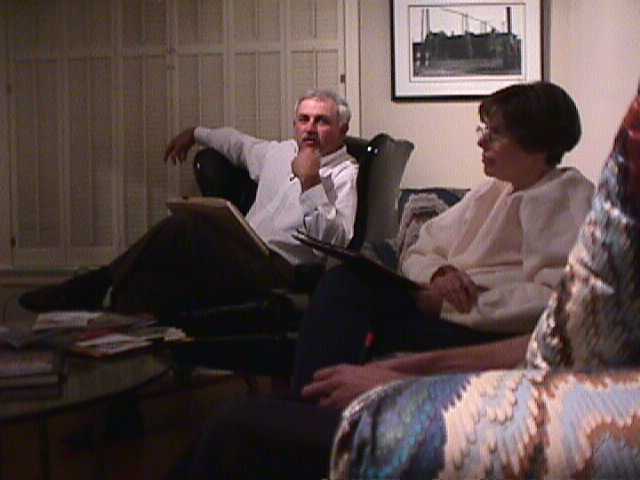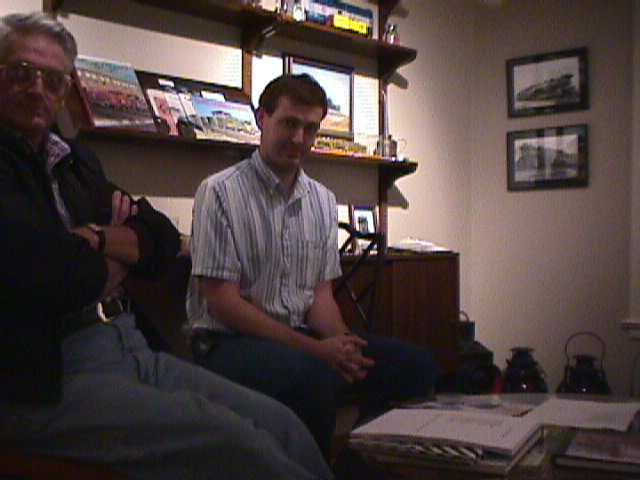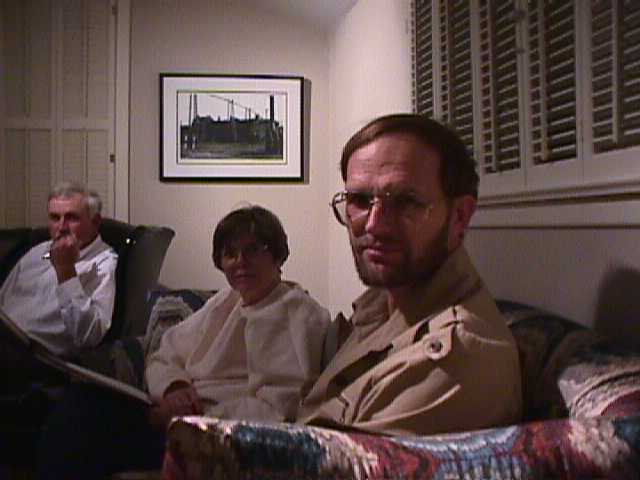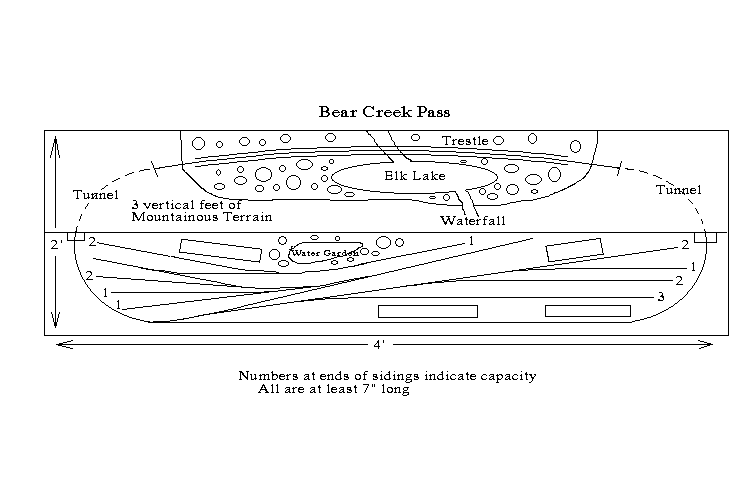<A NAME="dec98"></A>
Lubbock Model Railroad Association
Staying On Track - December 1998
Main Page
December 7 Meeting/Party
Monday, 7:30pm at Highland Baptist Activity Center, 34th and Quaker. We will have a gift exchange. Bring the kind of gift you would like to receive. There will be refreshments, but sorry, no business meeting.
New Board Elected
The board members for 1999 are Jerry Dukes, Marshall Higgins, Brad Jones, Nancy Reed, Jack Seay, Bob Batson, Ron Kutch, and Dave Lamberts. Patrick Pritchett will also serve as Deadwood.
Web Page and Newsletter Articles
http://home.earthlink.net/~jackseay . E-mail jackseay@sbcglobal.net mailto:jackseay@usa.net, . If you want to write a newsletter article or announcement (short or long), give it to me at the meeting, email it, call me: H 785-0068, W 792-6512, or send it to 5801-22nd St. #24, Lubbock, TX 79407. Articles for the web page can be encyclopedic.
Executive Committee Meeting
Tuesday, 7:30 P.M., December 15th, at Patrick Pritchett's house, 4702-16th. St. Both boards will meet in December. January, the new board will meet at Patrick's house and choose new officers.
LSR Play-Day
November 7 was the Lone Star Region playday and layout tour. Thanks to all who helped and opened their homes: Bob Batson, Bob Anconetani, Homer Morrow, Rip Maples, Bob Moulton, and Dave Lamberts. Special thanks to Nancy Reed for coordinating.
Science Spectrum Layout
We will have the club layout setup from December 5th to the 24th, second floor, by the atrium.
Pictures on Web Page
Jon Hays brought his digital camera to the last executive committee meeting and took a few pictures.

Patrick Pritchett and Jan Kutch

Marshall Higgins and Brad Jones

Patrick Pritchett, Jan Kutch, and Jack Seay

Life-Like SW9/1200
Dues - $12 Individual, $18 Family
Planning the Bear Creek Pass
For several years, I have been considering building a small N scale layout suitable for operations. My goals were the following: 1. Small enough to be portable. 2. Primarily for operations, but with a scenic area. 3. Avoid the artificial oval look of many small layouts. Real trains don't chase their tail around small ovals. (See Sept. '98 MR p. 16) 4. Provide space for display of a wood trestle. 5. Design trackwork for minimum derailments, easy coupling and uncoupling, and simple maintenance.
My first two layouts were both built before doing any operations. I was shocked after building them how quickly I got bored just watching the train run around and around and around.
I had already chosen the locomotive to use, the LifeLike SW9/1200 switcher. This little jewel runs like a Kato and only makes about one decibel more noise. These engines use a five-pole skewed-armature motor, meaning they have excellent slow running ability, a necessity for switching. After buying the Atlantic Coast Line switcher, I noticed it resembled Barney the dinosaur. Some weathering took care of that. Barney could also use some weathering to improve his color. While you're at it, weather all your kid's toys, especially the Beanie Babies. They will love you for it.
The size of the layout is 2 X 4 feet, divided by a backdrop into two 1 X 4 areas. On one side of the backdrop is the switching area, on the other side the curved real wood trestle. The total height, including removable base and backdrop, is six feet.
The scenic side is three feet of vertical scenery - one foot deep. The wood trestle is two feet long and eight inches high. Behind it is a small lake fed by a waterfall. Trees and shrubbery grow wherever the rock doesn't. I will make trees from the Arctic sage-brush type material from Scenic Express. These make better looking trees than the polyester fiberfill covered weeds I have used in the past. They have a very fine branch structure. Soak in matte medium and cover with coarse foam of several colors. The train will disapear inside a tunnel on both sides of the trestle, before traversing to the yard.
It took about five or six attempts to draw the switching area to eliminate all S-curves and get nine sidings with enough space to park fifteen cars and half of the oval - all in a 1 X 4 foot space. S-curves cause derailments, especially when backing. The fix is simple - have one car length of straight track between any curves that twist in opposite directions. Any of the layout design books explain more fully the hazards of S-curves and how to avoid them. I recommend "Design Handbook For Model Railroads" by Paul Mallory, published by Carsten's. I decided to eliminate a runaround track, as there wasn't space to park fifteen cars and a caboose on it. The loop itself will just have to suffice as a runaround. Some compromises have to be made on such a small layout. A triple switchback is in the yard, again not very realistic, but adding to the fun of operating, and giving some extra sidings. Here is a view of the track plan.

I spent some time in the building supply store looking at various woods and mouldings, then on the way home hit on the idea of making the benchwork look like a wooden trestle (approximately G scale). This is made in two sections. The lower eighteen inches detaches for transporting and is 2 X 4 feet. The top eighteen inches is 1 X 4 feet under the yard only. It is made by 1" X 2" furring strip lumber, stained dark walnut to resemble creosote. Since all the turnouts are manually switched, there aren't switch machines underneath, so the trestle design benchwork is not a problem.
Track is pre-weathered Micro-Engineering code 40 flex-track (about correct scale size for N scale - most N track is code 80). Code 55 track also looks very good. Turnouts are code 55 pre-weathered by Micro-Engineering. I have found pre-weathered track to be both easier to use and better looking than weathering it myself. Just use a fiberglass brush from Radio Shack to clean the rail before soldering. If you solder flex-track while straight before bending it into curves, it helps avoid the kinks at joints. Track is held directly to the masonite board by the matte medium or glue holding ballast in place. A 6:1 matte medium/water mix holds the ballast down, is clear, and flexible enough to remove by peeling up track and ballast together. All track is as flat and level as possible to make switching easier and eliminate derailments. Sidings are mostly straight to facilitate coupling and uncoupling.
The backdrop is 1/2 inch foam, removable for transport. It is darker blue at the top, fading to light blue at the bottom, with perhaps some distant looking mountainous shapes. Nothing fancy, just something to convey depth.
Scenery extends 1 1/2 feet above and 1 1/2 feet below the track on the trestle. The backdrop is 1 1/2 feet above the highest scenery. The removable benchwork is 1 1/2 feet beneath the lowest scenery.
A wood trestle on a modern railroad is a bit out of place, but I had to have just one. My next modern layout will probably use a steel one or a stone viaduct, as they withstand the weight of modern trains better, and don't burn as easily as the creosote coated wood ones.
On the switching side. The backdrop extends 3 feet above the track, and the trestle/benchwork extends 3 feet to the floor.
New SIG?
If you are interested in a home layout design and building SIG (any scale), contact me - Jack Seay.
Lubbock Western Timetable
December
7 - 7:30pm - Highland Baptist, Meeting and gift exchange
15 - 7:30pm - Joint meeting of the old and new boards
5 to 24 - Science Spectrum - club layout
January
5 - 7:30pm - Meeting
20 - 7:30 - Executive committee - new board
Main Page
Staying On Track - December 1998
December 7 Meeting/Party
Monday, 7:30pm at Highland Baptist Activity Center, 34th and Quaker. We will have a gift exchange. Bring the kind of gift you would like to receive. There will be refreshments, but sorry, no business meeting.
New Board Elected
The board members for 1999 are Jerry Dukes, Marshall Higgins, Brad Jones, Nancy Reed, Jack Seay, Bob Batson, Ron Kutch, and Dave Lamberts. Patrick Pritchett will also serve as Deadwood.
Web Page and Newsletter Articles
http://home.earthlink.net/~jackseay . E-mail jackseay@sbcglobal.net mailto:jackseay@usa.net, . If you want to write a newsletter article or announcement (short or long), give it to me at the meeting, email it, call me: H 785-0068, W 792-6512, or send it to 5801-22nd St. #24, Lubbock, TX 79407. Articles for the web page can be encyclopedic.
Executive Committee Meeting
Tuesday, 7:30 P.M., December 15th, at Patrick Pritchett's house, 4702-16th. St. Both boards will meet in December. January, the new board will meet at Patrick's house and choose new officers.
LSR Play-Day
November 7 was the Lone Star Region playday and layout tour. Thanks to all who helped and opened their homes: Bob Batson, Bob Anconetani, Homer Morrow, Rip Maples, Bob Moulton, and Dave Lamberts. Special thanks to Nancy Reed for coordinating.
Science Spectrum Layout
We will have the club layout setup from December 5th to the 24th, second floor, by the atrium.
Pictures on Web Page
Jon Hays brought his digital camera to the last executive committee meeting and took a few pictures.

Patrick Pritchett and Jan Kutch

Marshall Higgins and Brad Jones

Patrick Pritchett, Jan Kutch, and Jack Seay

Life-Like SW9/1200
Dues - $12 Individual, $18 Family
Planning the Bear Creek Pass
For several years, I have been considering building a small N scale layout suitable for operations. My goals were the following: 1. Small enough to be portable. 2. Primarily for operations, but with a scenic area. 3. Avoid the artificial oval look of many small layouts. Real trains don't chase their tail around small ovals. (See Sept. '98 MR p. 16) 4. Provide space for display of a wood trestle. 5. Design trackwork for minimum derailments, easy coupling and uncoupling, and simple maintenance.
My first two layouts were both built before doing any operations. I was shocked after building them how quickly I got bored just watching the train run around and around and around.
I had already chosen the locomotive to use, the LifeLike SW9/1200 switcher. This little jewel runs like a Kato and only makes about one decibel more noise. These engines use a five-pole skewed-armature motor, meaning they have excellent slow running ability, a necessity for switching. After buying the Atlantic Coast Line switcher, I noticed it resembled Barney the dinosaur. Some weathering took care of that. Barney could also use some weathering to improve his color. While you're at it, weather all your kid's toys, especially the Beanie Babies. They will love you for it.
The size of the layout is 2 X 4 feet, divided by a backdrop into two 1 X 4 areas. On one side of the backdrop is the switching area, on the other side the curved real wood trestle. The total height, including removable base and backdrop, is six feet.
The scenic side is three feet of vertical scenery - one foot deep. The wood trestle is two feet long and eight inches high. Behind it is a small lake fed by a waterfall. Trees and shrubbery grow wherever the rock doesn't. I will make trees from the Arctic
sage-brush type material from Scenic Express. These make better looking trees than the polyester fiberfill covered weeds I have used in the past. They have a very fine branch structure. Soak in matte medium and cover with coarse foam of several colors. The train will disapear inside a tunnel on both sides of the trestle, before traversing to the yard.
It took about five or six attempts to draw the switching area to eliminate all S-curves and get nine sidings with enough space to park fifteen cars and half of the oval - all in a 1 X 4 foot space. S-curves cause derailments, especially when backing. The fix is simple - have one car length of straight track between any curves that twist in opposite directions. Any of the layout design books explain more fully the hazards of S-curves and how to avoid them. I recommend "Design Handbook For Model Railroads" by Paul Mallory, published by Carsten's. I decided to eliminate a runaround track, as there wasn't space to
park fifteen cars and a caboose on it. The loop itself will just have to suffice as a runaround. Some compromises have to be made on such a small layout. A triple switchback is in the yard, again not very realistic, but adding to the fun of operating, and giving some extra sidings. Here is a view of the track plan.
I spent some time in the building supply store looking at various woods and mouldings, then on the way home hit on the idea of making the benchwork look like a wooden trestle (approximately G scale). This is made in two sections. The lower eighteen
inches detaches for transporting and is 2 X 4 feet. The top eighteen inches is 1 X 4 feet under the yard only. It is made by 1" X 2" furring strip lumber, stained dark walnut to resemble creosote. Since all the turnouts are manually switched, there aren't switch machines underneath, so the trestle design benchwork is not a problem.
Track is pre-weathered Micro-Engineering code 40 flex-track (about correct scale size for N scale - most N track is code 80). Code 55 track also looks very good. Turnouts are code 55 pre-weathered by Micro-Engineering. I have found pre-weathered track to be both easier to use and better looking than weathering it myself. Just use a fiberglass brush from
Radio Shack to clean the rail before soldering. If you solder flex-track while straight before bending it into curves, it helps avoid the kinks at joints. Track is held directly to the masonite board by the matte medium or glue holding ballast in place. A 6:1 matte medium/water mix holds the ballast down, is clear, and flexible enough to remove by peeling up track and
ballast together. All track is as flat and level as possible to make switching easier and eliminate derailments. Sidings are mostly straight to facilitate coupling and uncoupling.
The backdrop is 1/2 inch foam, removable for transport. It is darker blue at the top, fading to light blue at the bottom, with perhaps some distant looking mountainous shapes. Nothing fancy, just something to convey depth.
Scenery extends 1 1/2 feet above and 1 1/2 feet below the track on the trestle. The backdrop is 1 1/2 feet above the highest scenery. The removable benchwork is 1 1/2 feet beneath the lowest scenery.
A wood trestle on a modern railroad is a bit out of place, but I had to have just one. My next modern layout will probably use a steel one or a stone viaduct, as they withstand the weight of modern trains better, and don't burn as easily as the creosote coated wood ones.
On the switching side. The backdrop extends 3 feet above the track, and the trestle/benchwork extends 3 feet to the floor.
New SIG?
If you are interested in a home layout design and building SIG (any scale), contact me - Jack Seay.
Lubbock Western Timetable
December
7 - 7:30pm - Highland Baptist, Meeting and gift exchange
15 - 7:30pm - Joint meeting of the old and new boards
5 to 24 - Science Spectrum - club layout
January
5 - 7:30pm - Meeting
20 - 7:30 - Executive committee - new board
Main Page




